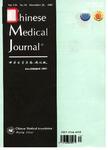Phenotype and genotype analysis of a Chinese family with prelingual X-linked hereditary hearing impairment
Phenotype and genotype analysis of a Chinese family with prelingual X-linked hereditary hearing impairment作者机构:Institute of Otolaryngology Chinese People's Liberation ArmyGeneral Hospital Beijing 100853 China Department of Otolaryngology First Hospital Affiliated to ChinesePeople's Liberation Army General Hospital Beijing 100037 China
出 版 物:《Chinese Medical Journal》 (中华医学杂志(英文版))
年 卷 期:2009年第122卷第7期
页 面:830-833页
核心收录:
学科分类:1004[医学-公共卫生与预防医学(可授医学、理学学位)] 1002[医学-临床医学] 100213[医学-耳鼻咽喉科学] 100401[医学-流行病与卫生统计学] 10[医学]
主 题:X-linked hearing impairment linkage analysis clinical feature
摘 要:Background X-linked hearing impairment is clinically and genetically a heterogeneous disease. Although many disorders manifest with hearing loss, a limited number of sex-linked loci and only one gene (POU3F4) have been shown to be implicated in X-linked non-syndromic hearing impairment. In the present study, we have performed a clinical and genetic analysis of a Chinese family with X-linked non-syndromic hearing loss, with emphasis on audiological findings and genomic mapping. Methods The clinical features of Family JX01 were evaluated by physical and audiometric examination in eighteen family members. Mutation screening of POU3F4 was identified by polymerase chain reaction (PCR) amplification and sequencing. Molecular evaluation consisted of X-chromosome wide genotyping by microsatellite makers (STR), followed by analyzing using MLINK computer program. Results Five affected males demonstrated bilateral, symmetrical sensorineural and profound hearing loss. The hearing impairment started prelingual. The female carriers did not have any complain of hearing loss, however, two of them were tested with milder loss with high frequency. No causative mutations in POU3F4 gene were detected by DNA sequencing. Linkage analysis indicated that the responsible gene was linked to locus DXS1227 (maximum Iod score=2.04 at θ=0). Conclusions The affected males in Family JX01 have profound prelingual sensorineural hearing impairment. In addition, two female carriers showed mild to moderate hearing losses. However, none of females complained of any hearing loss. Analysis of hereditary deafness in this family mapped most compatibly to the Xq27.2.



